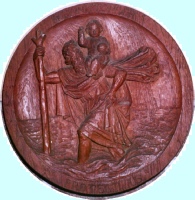

The Shore Establishment
HMS St. CHRISTOPHER needed hundreds of people to run it. Indeed, there were over a hundred pay office staff, cooks, stewards and supply staff alone while, in addition, there were some 30 full-time instructors.
The base headquarters building was the Highland Hotel in which could be found the pay and supply offices, the Training Officer, Captain, Engineering Officer and Supply Captain.
The Aircraft Recognition office was situated in the town square while 'Maybank', near the Highland Hotel served as the sick bay together with another building in Onich.
The town pier, now the Crannog restaurant, was home to a lookout post, the outline of which can still be seen in the present building.
An unnamed worker at the British Aluminium Smelter later reported: "Fort William became a Motor Torpedo Boat training centre - HMS St Christopher. On the large blank area on the landward side of the BA pier, the Navy built several large sheds with heavy concrete foundations for diesel engines, compressors and so on. On the landward berth a mother ship lay throughout the war. The whole place was guarded by Admiralty police but, of course, we had retained constant access. One job we did for the navy now and then was to coal some small ships. The coal came into our sidings with Admiralty labels. We put the wagons through our wagon tippler and grabbed the coal into skips which the pug (engine) ran down to the pier. Naturally Admiralty coal was vastly superior to what the public was getting and periodically the pug driver would report with a long face that he had had a wee mishap and a skip of coal had accidentally tipped going down the hill through the village. One day on a routine visit to the pier I hopped aboard a pug as it left and could see that the driver was slightly agitated. However, we rattled successfully down to the pier but I smiled inwardly at the sight of women and children with buckets and baskets lurking in the bushes. Presumably another wee mishap was supposed to have happened."
The ‘mother ship’ mentioned above was the armed motor yacht ‘Aberdonian’ which was used as a store for supplies and ammunition.
A number of hotels in the town served as accommodation for the men and women of the ship. The Grand Hotel was used as accommodation for Senior Officers. The WRNS were billeted in the Imperial, Palace, Grand and Station (House of Clan Jamfrie) hotels. Indeed, the Station Hotel also housed the galleys and a mess. Meanwhile trainee officers lived in the Waverley and Palace Hotels. The Palace Hotel ( then known as the Palace annex or 'Plex' is known today as Ossians Hotel while the Waverley was on the site now occupied by the Job Centre. Nissen huts also provided some additional accommodation. Meanwhile, a large forces canteen and cinema was built on the lawns at the parade end of the High Street.
Corpach seems to have been the main engineering and mechanical support location where the slipway and some of the various sheds and outbuildings can still be seen today. Buildings of particular note are the main torpedo stores which still have some of the internal fittings dating from that time and a long Nissen hut which was a small shooting range and is still used as a target range today.
Visitors today will find a memorial outside the front door of the Highland Hotel and some information about the Coastal Forces Veterans Association in the foyer.
A number of anti-aircraft batteries and search lights were located in the area. While they probably provided cover for the wider area which also included the Aluminium smelter. The foundations of a range finder could, until recently be seen protruding from the grass area in the middle of Caol shopping centre!
Depot Ships and other vessels associated with HMS St Christopher.
More pictures on the RCAHMS website
HMS St Christopher, Engineering And Mechanical Support Base
Also a 1945 aerial photograph on the NLS website
